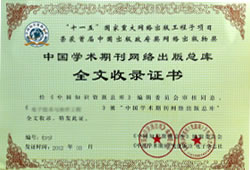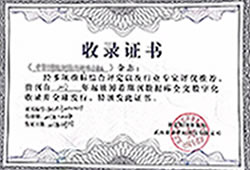《中国科学:技术科学(英文版)》是中国科学院主办、中国科学杂志社出版的自然科学专业性学术刊物。任务是反映中国自然科学各学科中的新科研成果,以促进国内外的学术交流。 《中国科学:技术科学(英文版)》以论文形式报道中国基础研究和应用研究方面具有创造性的、高水平的和有重要意义的科研成果。 在国际学术界,《中国科学》作为代表中国高水平的学术刊物也受到高度重视。国际上具有的检索刊物SCI,多年来一直收录《中国科学》的论文。1999年《中国科学》夺得国家期刊奖的及时名。
数据收录:CSSCI 南大核心期刊(中文社会科学引文索引)(含扩展版),北大核心期刊(中国人文社会科学核心期刊),CSCD 中国科学引文数据库来源期刊(含扩展版),统计源核心期刊(中国科技论文核心期刊),知网收录(中),维普收录(中),
期刊荣誉:
期刊级别:SCI核心期刊,CSCD核心期刊,
栏目设置:材料科学,机械工程,工程热物理,水利,空间科学,航空,土木工程,核科学与技术,电工,建筑,工程力学
Manuscript format
Contributions are required of a concise, focused account of the findings and reliable essential data. They should be well organized and written clearly and simply, avoiding exhaustive tables and figures. Authors are advised to use internationally agreed nomenclature, express all measurements in SI units, and quote all the relevant references.
Title: Titles must be limited to no more than 20 words, and should be concise, indexable, and informative for a broad scientific audience. Authors should avoid using colons, questions, nonstandard abbreviations, etc., in titles.
Author(s): Authorship should be limited to those who have contributed substantially to the work.
The order of the authors listed should be agreed by all the coauthors, and every author should have the responsibility for the published content.
Family names are written in upper case. The email address of the corresponding author is required.
Author affiliation: The affiliation should be the institution where the work was done. Complete addresses are required with post codes.
Abstract: An abstract is a summary of the content of the manuscript. It should briefly describe the research purpose, method, result and conclusion. The extremely professional terms, special signals, figures, tables, chemical structural formula, and equations should be avoided here, and citation of references is not allowed.
Keywords: A list of three to eight keywords should follow the abstract. The chosen keywords are required to reflect the theme of a manuscript.
Financial support: Financial support appears on the bottom of the title page, with grant number(s) following. The full title of each fund is required. For example: National Natural Science Foundation of China; National High-Tech Research & Development Program of China; National Basic Research Program of China.
Text: A paper should begin with a brief introduction of the significance of the author’s research. Nomenclature, signal, and abbreviation should be defined at their initial appearance. All the figures and tables should be numbered in numerical order.
Introduction: Being the most important part of an article, the introduction introduces the relevant research background and the progress in 2 or 3 years, with references cited in numerical order, then presents the problem to be solved in this article, and finally briefly describes the method adopted in this work. Before the end, the aim of the research should be mentioned. Subtitle is forbidden in this part, and introduction of the article structure is considered unnecessary.
Materials and method: This part introduces the materials, method and experimental procedure of the author’s work, so as to allow others to repeat the work published based on this clear description.
Discussion and conclusions: Conclusions should be derived from the observation and experimental results, and comparison with other relevant results is considered helpful to further proving the results. Repeated data should be
avoided, and conclusions and suggestions are required to be clearly expressed. New hypotheses and recommendations may be proposed when warranted.
Figures and tables: Figures and tables should be numerically numbered, inserted in the text, and cited in order within the text. The figures should have resolution not lower than 600 dpi and clear lines of 5 px, with signals and letters in Times New Roman at8 pt. A space should always be maintained between the variable and the unit.
Equations: An equation is numerically numbered (Arabic numeral), and has the number put on its right side.
Acknowledgements: The author expresses his/her thanks to the people helping with this work, and acknowledges the valuable suggestions from the peer reviewers.
References: Reference citation is regarded as an important indicator of the paper quality. If the relevant references, especially the results published in 2 to 3 years are not cited in the paper, or most citations are from the author’s publications, the editor will consider this paper unattractive. References should be numerically numbered and cited in order within the text, with the numbers expressed in square brackets. The author should carefully check the author names, article title, journal title, year, volume and issue number of references, and create the listing according to the format of Sci China Ser E-Tech Sci.
Reference format
1. For an author’s name, full spelling of family name appears before abbreviation of given name, with a spacing in the middle.
2. If there are more than 3 authors, the first 3 names are followed by et al.
3. The article title should be identified by an initial capital letter with the remainder of the title in lower case.
4. For correct abbreviations of journal titles, refer to ISO, e.g., Chin Sci Bull for Chinese Science Bulletin, Sci China Ser C-Life Sci for Science in China Series C-Life Sciences.
5. For books and proceedings, the initial letter is capitalized for all the notional words and for function words with more than 4 letters.
6. Do not forget to list the editor names of the proceedings, the publisher, the publishing address, and the beginning and terminating pages.
7. Accepted but unpublished papers should be followed by “in press”.
8. Websites or homepages cannot be cited as references.
投过好几个同类型的期刊,都是直接拒稿,一两月没消息,审稿机会都不给。同档次的《Science China Technological Sciences》期刊给审稿了,一个星期就发消息告诉我怎么修改而且写的很 详细。效率高,不排外。必须赞一个!
论文被 scoop(抢先发表)是怎样一种体验?那段时间几乎天天都在想,如果稿件没被录用该怎么办。
法学生想发表论文拿个学分,在普刊的话,有没有推荐呢?
我的论文已经写好了,怎么样可以迅速发表?
有的学者说,正确的理论只能在适当的时机发表出来,说早了,会挨批甚至挨整;说迟了,落后于实践,也就丧失了其价值
新手如何去写好一篇论文呢?我们应该注意些什么?首先是论文的选题,题目要得当主题要突出,因为好的题目才能引起读者的兴趣,吸引阅读者阅读下去。其次是摘要必须要简练,不必把所有的东西都展示在摘要里面,只要把
最让我满意的是纸张。书页光滑清晰,手感翻动的感觉相当好。而且页面上还有淡淡的油墨清香。书里面夹叠的地图基本保持了清晰,插图也可以,没有排版混乱跟错别字。


期刊发表咨询服务,1-3天快速下单, 1-3月即可见刊!
文章原创检测,精确、权威、快速。
文章编辑老师亲自指导发表,客户满意为止!
国内学术期刊分为核心和普刊,根据自己不同的需求,选择核心期刊或者普刊。大部分情况下在校大学生发表论文普刊就可,核心除非是有导师带着才有可能发表一篇核心。